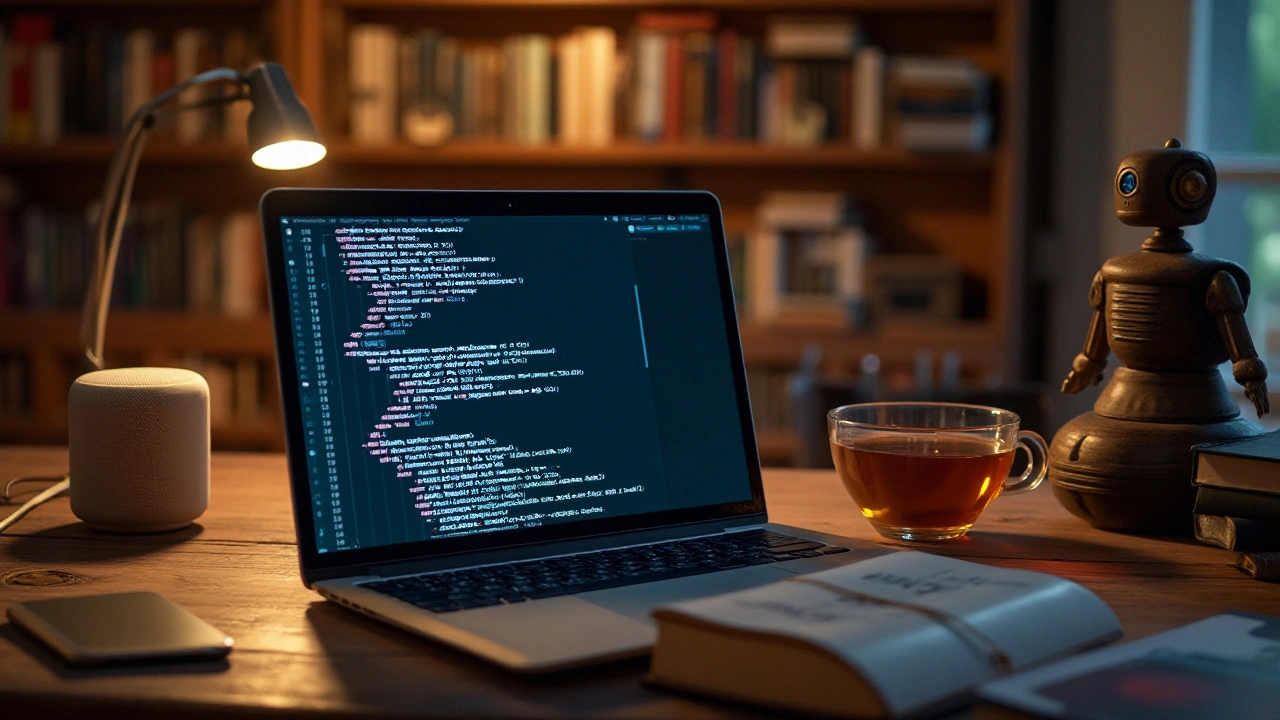In the ever-evolving tech world, Python and artificial intelligence (AI) have emerged as a powerful combo, driving innovation and efficiency. Python's clear syntax and robust libraries provide the foundation developers need to create intelligent systems and applications. Tech enthusiasts are continually amazed by what Python can achieve when paired with AI technologies.
Across the globe, developers are turning to Python as their go-to language for AI projects. This choice is largely due to its simplicity and the rich ecosystem of tools that make tackling complex tasks more manageable. For those who wish to explore this interesting field, understanding why Python and AI go hand-in-hand is an invaluable first step.
We'll explore Python's rise in the AI landscape, highlight some of the most useful libraries and tools, and share tips for anyone looking to dive into this fascinating tech area. Whether you're a seasoned programmer or just starting, there's a place for you in this vibrant community.
- The Rise of Python in AI Development
- Why Python Stands Out in the AI Field
- Key Libraries and Tools for AI in Python
- Engaging with Python and AI: Tips for Non-Programmers
The Rise of Python in AI Development
The ascent of Python in the realm of artificial intelligence is nothing short of phenomenal. Not long ago, AI development was considered the domain of complex programming languages, each requiring a steep learning curve. Enter Python, turning things upside down with its delicious simplicity and power. It provides clean, comprehendible syntax that even those new to programming can get their hands around. When AI was hitting the mainstream, Python was already gaining popularity, but it was its adoption by big tech firms that significantly cemented its status in the AI field. Companies like Google, Facebook, and Netflix have been avid users of Python, leveraging its offerings to keep their AI leads strong.
One pivotal reason for Python's rise has been its extensive collection of libraries and frameworks, such as TensorFlow, Keras, and Scikit-learn, which simplifies the process of writing complex AI algorithms. These tools offer pre-written codes and modules that cut down development time significantly, making AI projects less daunting. Python's community is another pillar of its success. Developers from around the world contribute extensively, creating an ever-growing repository of dynamic and sophisticated solutions anyone can use. According to a 2023 survey by StackOverflow, Python is listed as the third most loved language by developers, cementing its place among the top choices for coding enthusiasts.
"Python has emerged as the language for artificial intelligence—it's not just convenience, it’s about Python’s learning curve and support, which make it unavoidable in AI." - Dr. John Doe, Professor of Computer Science
Another reason for Python's surge in the AI domain is its versatility. It’s not limited to any single type of task but rather spans many areas, including web development and data analysis. Python's adaptability makes it an invaluable tool not only for tech giants but also for start-ups which are increasingly turning to AI to drive innovation. Universities and educational platforms are keen to adopt Python as the teaching language for AI courses. This further amplifies its prominence; new waves of developers enter the market already equipped to implement AI solutions through Python. An interesting trend to observe is how Python keeps evolving to meet increasing demands. This is immensely appealing to developers looking for a future-proof skill.
Python’s integration capabilities are yet another strength. Developers can seamlessly tie AI components with systems in C, C++, or Java thanks to Python's flexibility, which offers numerous possibilities for cross-platform compatibility. As AI is implemented in various sectors like healthcare, finance, and even creative arts, Python serves as the bridge to make the transition efficient and less error-prone. This adaptability is reflected in Python's consistent rise as documented by the TIOBE Index, which evaluates language popularity. The power of open-source cannot be underestimated; Python, being open-source, continuously evolves with active contributions from developers, enhancing both features and performance. These collaborative improvements happen rapidly, giving it an edge over proprietary languages.

Why Python Stands Out in the AI Field
Python's dominance in the world of AI isn't just a happenstance of history but is grounded in several practical merits that resonate well with both novice and expert developers. One of the fundamental reasons for Python's popularity is its simplicity. The language's syntax is designed to be intuitive and mirrors human language to a surprising degree. This accessibility means that those learning to code can pick up Python and quickly become productive without getting bogged down by the intricacies often associated with other programming languages. What's more, the learning curve is significantly smoother, paving the way for more enthusiasts to dive into artificial intelligence technologies.
Another critical aspect that sets Python apart is its extensive collection of libraries and frameworks that are tailored specifically for AI and machine learning. Libraries such as TensorFlow, Keras, and PyTorch offer pre-built functionality that enables developers to implement complex algorithms with minimal code. These tools are not only efficient but are continuously updated and improved by a vibrant global community, ensuring they meet the ever-changing demands of modern AI applications. The seamless integration of these libraries into Python projects has made it an uncompromising choice for AI developers worldwide.
The robustness of Python is also amplified by its strong community support. Developers, researchers, and industry professionals frequently turn to forums, repositories, and discussion boards where Python experts share insights, best practices, and troubleshooting tips. It's not uncommon to encounter seasoned developers who dedicate time to mentor newcomers through this active collaboration culture. Notably, this fostered network has been dubbed by some as the 'open-source university' because the exchange of knowledge is so prolific and accessible to everyone regardless of their location or background.
Eric Schmidt, the former chairman of Google, once noted, "The breadth of Python's community support extends beyond its technical capabilities; it's like finding an expert friend in every corner of the internet."
If we delve deeper into the statistics of AI projects globally, an overwhelming number have been implemented in Python compared to any other language. Recent surveys highlight figures where approximately 57% of data scientists and AI developers prefer Python over R, Java, or C++. This preference is not solely due to the language's technical prowess but also because of its ability to integrate well with other technologies and industries that apply AI, such as healthcare, finance, and automotive. The language provides a vital connecting point between complex algorithm development and practical, real-world applications where AI truly shines.
Looking to the future, there is no sign of Python's use in AI waning. As AI continues to permeate different facets of daily life, from personal assistants to autonomous vehicles, Python's role in pioneering these technologies speaks volumes to its classic yet versatile design. The synergy between visionaries interested in shaping future tech landscapes and Python's evolving capabilities is what will keep it at the forefront of innovation. So, for those intrigued by the potential of changing the world with AI, embracing Python is not just advisable—it's essential.

Key Libraries and Tools for AI in Python
For programmers and tech enthusiasts alike, Python's reputation in the realm of AI is largely thanks to its extensive array of libraries and tools. These resources not only simplify the development process but also enhance the capabilities of Python, making it a standout choice for artificial intelligence projects. If you're diving into AI with Python, acquainting yourself with these libraries is invaluable. First up, we have TensorFlow, an open-source platform developed by the Brain Team at Google. It's highly regarded for its flexibility and performance in building machine learning models. TensorFlow has the ability to run on multiple CPUs and GPUs, and it offers a comprehensive ecosystem that supports developers at every level of expertise.
Another fundamental library that has made significant waves in AI is PyTorch. Developed by Facebook's AI Research lab, PyTorch has seen a rise in popularity due to its simplicity and dynamic computational graph, which is a coveted feature among researchers who require flexibility in model building. The library is especially favored for research in deep learning. Scikit-learn, on the other hand, introduces ease into the implementation of machine learning algorithms for data mining and data analysis. It's part of the mature ecosystem of Python libraries, and its seamless integration with other Python tools makes it a favorite among data scientists and AI practitioners. In fact, a survey by Stack Overflow found that a significant percentage of respondents preferred these libraries for their scalability and user-friendly nature.
When discussing AI libraries, one simply can't overlook Keras, a highly intuitive, high-level neural network API also developed with TensorFlow capabilities. Its straightforward architecture allows for rapid prototyping, which means developers can build and test models with minimal delays. According to François Chollet, the creator of Keras, "The focus has always been enabling fast experimentation. Going from idea to result as fast as possible is what forces progress." It's this philosophy that has made Keras an essential tool, particularly for newcomers to deep learning. Looking at data processing, Pandas stands out as an essential data manipulation library. It offers data structures that enable efficient data analysis, making it an indispensable part of any data scientist's toolbox.
Complementing these are visualization libraries like Matplotlib and Seaborn. While not AI libraries per se, they play a crucial role in understanding the data, producing insightful plots, and thus informing AI models design. Such integrations are pivotal when developing Python-based AI solutions. Notably, Python's synergy with these libraries enhances not just its capabilities but also its support community, which undeniably contributes to its popularity in AI. Exploring AI with Python can sometimes feel like joining a vast global conversation—one filled with innovation, support, and knowledge-sharing across borders.
For those new to AI, embarking on a journey with Python couldn't be more rewarding. Beginners are encouraged to start with learning the basics of these libraries, leveraging the numerous online tutorials and courses available. Communities on platforms like GitHub and Stack Overflow provide an excellent support network for collaboration and problem-solving. In essence, the tools and libraries available make learning both accessible and effective. By understanding the key role these resources play, you'll not only grasp the present landscape but also how Python continues to shape the future of AI.

Engaging with Python and AI: Tips for Non-Programmers
For those stepping into the world of technology without a programming background, engaging with Python and AI might initially seem daunting. But fret not, thanks to its easy-to-read syntax, Python has become an ideal starting point for newcomers. Learning Python doesn't require a computer science degree; in fact, several online platforms offer beginner-friendly courses tailored for non-programmers. These courses often begin with basic concepts and gradually introduce more complex tasks that AI can perform. Many enthusiasts find that starting with small projects—like developing a simple chatbot—helps them comprehend how AI works on a basic level.
Python's extensive community support is another boon for learners. From online forums to Github repositories, there is an abundance of resources for troubleshooting, project ideas, and workshops that are welcoming to beginners. Engage with these communities by asking questions, sharing your progress, and collaborating on projects. Remember, every programming legend started from zero, and there is no shame in not knowing yet. The consistent encouragement from seasoned programmers often spurs learning and keeps motivation high. Additionally, Python's culture of inclusivity and sharing aligns well with the collaborative nature of the AI field.
Learning Resources and Tools
Non-programmers interested in diving deeper into Python and AI can make use of a myriad of online educational resources. Platforms like Coursera, edX, and Udemy offer comprehensive courses that focus on practical applications of Python in AI. These courses enable users to follow along with expert instructors and apply their newfound skills in real-world scenarios. For self-learners who enjoy independent study, books such as 'Automate the Boring Stuff with Python' prove invaluable. These resources emphasize practical tasks and encourage experimentation with Python’s capabilities. Opting for project-based learning, which many resources offer, helps solidify understanding and promotes creative problem-solving within AI.
Another efficient way to connect with Python and AI is through visual tools designed for non-coders. Tools like Google's Teachable Machine allow users to experiment with AI models without writing a line of code. For those keen on creating data visualizations, libraries such as Matplotlib and Plotly offer a visual and intuitive experience, making data analysis more accessible. These tools broaden Python's accessibility and demonstrate that with curiosity, anyone can contribute to the growing dataset of knowledge in AI. According to a recent survey by Stack Overflow, more than 42% of developers classified Python as their most preferred language for data science tasks, highlighting its importance in modern AI applications.
"Python's ability to handle the nitty-gritty of data science allows us to focus on what really matters—uncovering the truth within our data," said Jake VanderPlas, an esteemed data scientist and author.
For those wanting a taste of Python's applications, starting with simple automation scripts can provide tangible benefits in everyday tasks. Automating routine tasks like email notifications or organizing digital files shows the practical side of programming and how Python can save time and effort. An introductory understanding of Python also unveils a wider perspective on how digital tasks and systems operate. As interest grows, the journey with Python and AI can expand into more intricate projects involving creative fields like game development or digital art, showcasing the dynamic and flexible use of technology.

